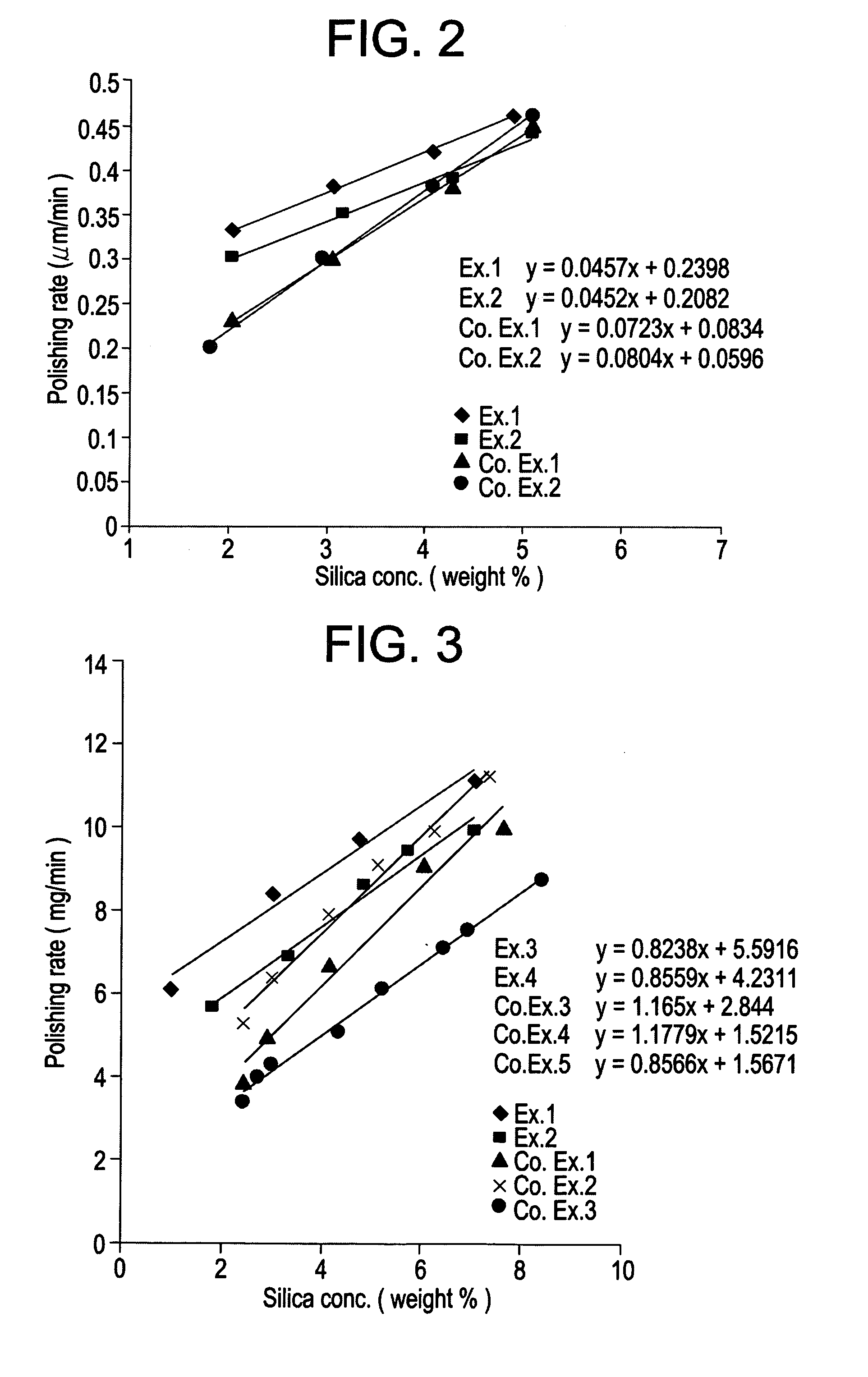Polishing compound for semiconductor wafer polishing and polishing method
a technology of polishing compound and semiconductor wafer, which is applied in the direction of lapping machine, manufacturing tools, other chemical processes, etc., to achieve the effect of small change in polishing rate according to concentration chang
- Summary
- Abstract
- Description
- Claims
- Application Information
AI Technical Summary
Benefits of technology
Problems solved by technology
Method used
Image
Examples
preparation example 1
[0093]520 g of JIS 3 sodium silicate (SiO2: 28.8 weight %, Na2O: 9.7 weight %, H2O: 61.5 weight %) is added to 2810 g of deionized water, mixed homogeneously and diluted sodium silicate of silica concentration 4.5 weight % is prepared. This diluted sodium silicate is passed through a column containing 1200 mL of H type strong acidic cation exchange resin (AMBERLITE IR120B, product of ORGANO CORPORATION), which is previously regenerated by hydrochloric acid and dealkalized, then 4040 g of active silicic acid characterized that silica concentration is 3.7 weight % and pH is 2.9 is obtained.
[0094]Then, colloidal particles are grown up by a build up method. That is, to 500 g of said obtained active silicic acid, 20 weight % TEAOH aqueous solution is added by stirring and pH is adjusted to 9, heated to 90° C. to boiling point and preserved for 1 hour, then remaining 3540 g of active silicic acid is added by 6 hours. During adding process, 20 weight % TEAOH aqueous solution is added so as...
preparation example 2
[0095]520 g of JIS 3 sodium silicate (SiO2: 28.8 weight %, Na2O: 9.7 weight %, H2O: 61.5 weight %) is added to 2810 g of deionized water, mixed homogeneously and diluted sodium silicate of silica concentration 4.5 weight % is prepared. This diluted sodium silicate is passed through a column containing 1200 mL of H type strong acidic cation exchange resin (AMBERLITE IR120B, product of ORGANO CORPORATION), which is previously regenerated by hydrochloric acid and dealkalized, then 4040 g of active silicic acid characterized that silica concentration is 3.7 weight % and pH is 2.9 is obtained.
[0096]Then, colloidal particles are grown up by a build up method. That is, to 500 g of said obtained active silicic acid, equimolar mixture of 20 weight % TEAOH aqueous solution and 25 weight % TMAOH aqueous solution is added by stirring and pH is adjusted to 9, heated to 90° C. to boiling point and preserved for 1 hour, then remaining 3540 g of active silicic acid is added by 6 hours. During addin...
preparation example 3
[0097]520 g of JIS 3 sodium silicate (SiO2: 28.8 weight %, Na2O: 9.7 weight %, H2O: 61.5 weight %) is added to 2810 g of deionized water, mixed homogeneously and diluted sodium silicate of silica concentration 4.5 weight % is prepared. This diluted sodium silicate is passed through a column containing 1200 mL of H type strong acidic cation exchange resin (AMBERLITE IR120B, product of ORGANO CORPORATION), which is previously regenerated by hydrochloric acid and dealkalized, then 4040 g of active silicic acid characterized that silica concentration is 3.7 weight % and pH is 2.9 is obtained.
[0098]Then, colloidal particles are grown up by a build up method. That is, to 500 g of said obtained active silicic acid, 25 weight % TMAOH aqueous solution is added by stirring and pH is adjusted to 9, heated to 90° C. to boiling point and preserved for 1 hour, then remaining 3540 g of active silicic acid is added by 6 hours. During adding process, 20 weight % TEAOH aqueous solution is added so as...
PUM
| Property | Measurement | Unit |
|---|---|---|
| molar ratio | aaaaa | aaaaa |
| pH | aaaaa | aaaaa |
| particle size | aaaaa | aaaaa |
Abstract
Description
Claims
Application Information
 Login to View More
Login to View More - R&D
- Intellectual Property
- Life Sciences
- Materials
- Tech Scout
- Unparalleled Data Quality
- Higher Quality Content
- 60% Fewer Hallucinations
Browse by: Latest US Patents, China's latest patents, Technical Efficacy Thesaurus, Application Domain, Technology Topic, Popular Technical Reports.
© 2025 PatSnap. All rights reserved.Legal|Privacy policy|Modern Slavery Act Transparency Statement|Sitemap|About US| Contact US: help@patsnap.com


